May 27, 2014
In Rewriting The Fat Burning Textbook – Part 1 you discovered how eating a high fat diet doesn’t make you fat, and may actually increase the amount of fat you burn as fuel at both rest and during exercise, allow you to exercise or function for longer periods of time while eating relatively few calories, massively improve your health and not limit performance in the least.
But much of that information is theoretical, and not grounded in hard, sweaty numbers. Sure, there are videos such as this that suggest high-fat diets and ketosis-adapted performance can aid with things such as fat loss and high-altitude resilience, but there is scant data related to the pointy end of human performance potential.
However, what if we could actually prove that eating a low-carb, high-fat diet for a long time, becoming fat-adapted and even avoiding carbohydrates during the one time when we’re most encouraged to consume carbohydrates (during exercise)…
…could actually turn you into a fat-burning machine without losing a shred of performance capability or causing any metabolic damage?
That, my friends, would rewrite the fat-burning textbooks.
Let’s find out if it can be done…
——————————————–
Enter The Exercise Nerds: The FASTER study at the UCONN Human Performance Laboratory
As you’ve already learned – from controlling cancer to reducing your waistline to biohacking your brain – a high fat and low carb diet has been shown to massively enhance health, energy levels, and focus while reducing risk of disease. But what does a high-fat diet do to the body when you’re exercising? Does it actually cause you to burn more fat as fuel? Does it mess up your gut? Does it drain precious muscle and liver energy stores?
And most importantly: can you turn yourself into a complete fat burning machine without losing a shred of performance capabilities?
These are all complete unknowns.
Until now.
Just several weeks ago – after following a strict high fat diet for 6 months – myself and a group of other fat adapted athletes walked into the prestigious Human Performance Laboratory at University of Connecticut for a battery of unpleasant tests that would answer these questions, including:
-defecating into a collection tray so that scientists can inspect how a high fat diet affects gut bacteria and microbes…
-running at an extreme incline on a treadmill until complete volitional fatigue while bleeding lactate out the fingertips…
-taking an X-Ray radiation scan for visualization of body fat mass and skeletal structure…
-having a cannula inserted to collect blood samples throughout a day of exercising to investigate cholesterol, triglycerides, inflammation, glucose and white blood cells……
-getting a biopsy needle jammed into the muscle to extract 200 milligrams of tissue, and another biopsy needle jammed into the butt to extract samples of fat tissue…
This will all culminate with a 3 hour endurance run sufferfest on the lab treadmill, while continuing to bleed into test tubes, salivate onto cheek swabs and breathe into a gas-analyzing mask.
The results will eventually be published in a scientific paper by high-fat diet guru and researcher Jeff Volek. But I’ve been given exclusive permission by UConn researchers to jump the gun and write an blog post about the entire experience and the results. In this post, I’ll provide everything: the gory photos, the lab rat details and most importantly, whether the average exercise enthusiast can really benefit from a high fat diet.
To make things easy to understand, I’ve broken the entire study process into 13 steps.
Let’s jump right in, shall we?
——————————————————-
12 Steps To Turn Yourself Into A Fat Burning Machine and Prove You Don’t Really Need Carbs
Step 1: Follow A High Fat Diet For 6 Months
The UCONN study enrolled highly trained male and female ultra-endurance athletes (e.g. ultra-marathoners, Ironman triathletes, etc.) who have strictly consumed a low carbohydrate diet (defined as less than 20% of calories from carbohydrate) or a high carbohydrate diet (defines as more than 55% of calories from carbohydrate) for at least 6 months.
As you’ve probably guessed by now, I was one of the low carb guys.
In my article at “How Much Carbohydrate, Protein and Fat You Need To Stay Lean, Stay Sexy and Perform Like A Beast?”, I describe how to practically pull off a 20% or lower carbohydrate based diet. In another article, “The Great Ketogenic Ironman Experiment” article, I describe how to tweak a low-carb diet to go as low as 5% carbohydrate intake (also known as ketosis).
But in case you’re purely interested in the food porn, and how one pulls off a high-fat diet for 6 months without being married to a coconut milk subscription on Amazon, here are some sample staple meals I ate during those 6 months:
1. Beef bone marrow – one of the most nutrient-dense fat-packed foods on the face of the planet, photographed here with broiled carrots, onion and kale. Click here to read more about the wonders of bone marrow.

2. Eggs n’ avocados – this omelette, avocado and pitcher of olive oil were photographed on my hotel room bed the day I arrived at UCONN, about 24 hours prior to the onset of testing.
3. Smoothies – I travel quite frequently, and have found that hotel buffet breakfast bars often have blenders. In a case like this, I ask for things like an avocado, spinach or kale, coconut milk, butter, olive oil, seeds, and nuts, and simply have them dump it all into the blender. In a case like this, photographed at a hotel in Cancun, Mexico, the green slosh wound up in a bowl, topped with pumpkin seeds.
Is there potential for low hormones, low blood pressure or metabolic damage while following a strict low carbohydrate diet?
Absolutely.
But here are some steps I took to control that damage.
—————————————
Step 2: Test Oxygen Utilization and Blood Lactic Acid
To set a baseline for the 3 hour treadmill run that was to take place the following day, I underwent one of the most brutally intense exercise science tests that exists: a V02max treadmill protocol. This was to me on the research study waiver as “a incremental treadmill test that will continually increase intensity until you achieve volitional fatigue”. In other words: I was expected to run until I would nearly pass out and fall off the back of the treadmill. After warming up, this test usually takes about 12 minutes, with significant increases in speed and grade every two minutes.
Before each two minute stage, I took a brief stop for needle-yielding researchers to take single drop of blood from my finger to analyze blood lactate concentration. Blood lactate is the gold standard for determining when your muscles begin to produce more lactic acid than they can actually remove. Blood lactate levels during exercise are also a parameter that’s never been measured during exercise in fat-adapted athletes. Since a fat adapted person is burning less carbohydrate, they should theoretically produce less lactic acid, resulting in less burn and less discomfort during exercise – a convenient biohack indeed…
For you physiology nerds – here is a .pdf download the VO2 Max Results. Notice the significant carbohydrate utilization only during the final two minutes of extremely intense exercise.
—————————————
Step 3: 24 Hour Urine and Stool Collection
It’s known that your macronutrient ratios (carb/fat/protein ratios) drastically affect the bacteria in your gut, and that influences everything from neurotransmitter production to performance to propensity for obesity (hence the current pursuit of a bacteria-based “fat drug”).
So for this study, I was not only required to collect 24 hours of urine in a fancy, orange container (to strictly monitor hydration status, and also to measure nitrogen content of my urine)…
…but I was also required to poop in a yogurt-carton sized plastic container and hand in a stool sample so that the researchers could look at bacteria and microbes from my gut. The fecal samples will be used to analyze my microbiome using (and this exactly how it was described to me by the researchers) “next generation sequencing techniques which target the bacterial 16S rRNA gene”. Apparently this is very similar to type of testing being utilized by the fascinating American Gut Project.
—————————————
Step 4: DEXA Scan
Believe it or not, those electronic scales you step on for body fat measurements can be notoriously inaccurate. Instead, the gold standard measurement for body composition (fat percentage, muscle percentage, and bone weight/density) is determined by using a machine called a “DEXA scanner” . That’s right: the same type of scanner used to diagnose osteoporosis can also tell you how fat you are. During my DEXA scan, I lay quietly and completely still on a table while a certified X-ray technician directed a scanning arm to pass over my body from head to toe, taking about 5 minutes to analyze my entire fat content.
You might be interested in the results you’ll find on the table below if you would like to allay any fears that a high fat diet will make you fat. I’m actually far leaner than when I was eating a low fat diet.
Warning: If you decide to get a DEXA scan to measure your own body fat, muscle percentage and bone density, you will be exposed to a very small amount of radiation by the scanner used to measure your body composition. Exposure to any amount of X-ray radiation, no matter how low, may cause abnormal changes in cells. However, the body continuously repairs these changes – and the amount of radiation is very low in just one DEXA scan The total exposure for the whole body scan is approximately 125 times less than the average radiation from a standard chest X-ray.
Here is a .pdf download of my DEXA results. Do you find it interesting that a 60%+ fat based diet still results in 5.2% body fat? Shocking, eh?
Eating fat doesn’t make you fat, folks.
—————————————
Step 5: Muscle and Fat Biopsy
Now comes the fun part – a pre-workout muscle and fat biopsy to determine carbohydrate storage, and whether a high-fat diet has left me “carb drained”. In addition to measuring carbohydrate storage, the muscle analysis can look at how my fat-adapted muscles could support a theoretically larger-than-normal level of fat oxidation. The biopsy allows for measurement of muscle glycogen, triglycerides, fiber type, markers of inflammation and immunity, and even specific expression patterns for some genes.
Here is exactly how the muscle biopsy was described to me by the researchers:
“For this procedure you will lie down on a comfortable hospital bed before exercise. We will use a local anesthetic to numb an area of your skin and thigh muscle before obtaining a small amount of muscle via a muscle needle biopsy. This is the first of three muscle biopsies that will be taken, including one immediately after exercise and one two hours after exercise.
While Lidocaine does a good job of eliminating the sharp pain of an incision, it cannot fully eliminate the dull pain associated with doing the biopsy. The biopsy needle is about the same diameter as a Bic pen. After the incisions in the skin and fascia are made, the needle will be inserted through them into the muscle. The biopsy needle will likely cause the muscle to cramp for a second. Once in place, the needle will be used to make three or four “snips” in the muscle, which will be removed from you. The total amount of muscle removed will be between 50 and 200 mg, or a total amount about the size of an unpopped popcorn kernel. After this, the needle will be withdrawn, some pressure will be put on the site to control bleeding, and the incision will be closed either with one suture. You will not notice this muscle missing, either cosmetically or functionally. There are studies where more than 400mg have been removed without problems.
After the procedure, you will have a pressure dressing applied to the site and your thigh will be wrapped with a compressive wrap. It will be tight, but should not be painful. The night of the procedure, you will be instructed to keep your knee bent as much as possible, apply ice to your thigh, avoid heat or massage, and avoid anti-inflammatory medication.
It is vital that you understand that your thigh will hurt after a muscle biopsy. The pain you will feel will be like a deep “Charley Horse” and will typically improve over 48-72 hours. It is impossible to quantify the pain for you. Everyone's experience with pain is unique, and one's sensation of pain is influenced by multiple other factors than just the procedure itself. The exact same procedure, done the exact same way, will be felt differently by different people. It will even vary in the same person if they have multiple biopsies over time. There have been situations where people have hurt for more than a week. The more accurate expectation is 48-72 hours of tolerable aching in your thigh. After the first night, you will be allowed to exercise in any way you tolerate.”
Want the short version? They jam a needle into your leg, cut out muscle to freeze dry, and it hurts like a mother-f&*#er. Especially later that night.
The fat biopsy (AKA cheap liposuction) was relatively similar, and described to me as follows:
“Prior to each of the three muscle biopsy procedures, we will obtain a small piece of fat beneath the skin from the outer upper quadrant of the buttock under local anesthesia using a needle. The buttock area is chosen because the participants in this investigation are lean, and this area is likely to yield greater access to fat relative to other common sites (e.g., abdomen, quadriceps, etc.). A 16 G needle (about as thick as a penny) will be adapted to a syringe filled with sterile normal saline in order to apply suction. The needle will be inserted into the subcutaneous fat and the tissue will be “suctioned” by the syringe. The needle will be repeatedly inserted and retracted a couple of times in the fat layer to obtain at least 2 mg tissue (about a drop of water) up to about 100 mg (equivalent weight of a toothpick).”
Despite promises of just a toothpick size portion of fat, this one also hurt like a mother-f&*#er. All gory photo details below.
———————————————–
Step 6: Blood Draws
I’ve always been a big fan of self-quantification, and for the past 2 years have done regular blood testing to track parameters such as “What Kind Of Damage Happens To Your Body After You Do A Hard Workout, Triathlon or Marathon?” and “What Happens When You Combine Low Carb and Extreme Exercise?”. So a fasting blood sample was nothing new to me.
But it was certainly a new experience to give 12 different three-tablespoon sized blood samples at multiple intervals throughout the day, including 4 times during a 3 hour treadmill run. By the end of the day, I felt like a pincushion, and had arms peppered with so many needle dots that I looked like a relatively fit heroin-addict.
For this study, the blood test was for basic health related blood markers such as cholesterol, triglycerides, glucose, insulin, and inflammatory markers, and white blood cells.
You can click here download a pdf blood testing results., which show typical results you’d see from an athlete or someone who exercises a lot: high BUN and high creatinine from muscle breakdown, high RDW (Red cell distribution width) and low alkaline phosphatase from constant turnover of red blood cells. These are not big red flags, but just a natural consequence of beating up the body day-after-day.
—————————————
Step 7: Resting Metabolic Rate (RMR) Test
Your body burns a specific number of calories per day for vital organ activity, such as automatic functioning of your heart and lungs, nervous system electrical activity, kidney function, liver detox, digestion, hormone production, subconscious muscle contractions, and skin temperature. Your resting metabolic rate (RMR), is the total amount of energy you expend daily on these type of functions – without taking into account physical activity such as climbing a flight of stairs, exercising, standing up, sitting down, etc..
A resting metabolic rate test measures your carbohydrate and fat oxidation by calculating a number called an “Respiratory Exchange Ratio” (RER). Your RER is determined by the ratio of carbon dioxide (CO2) you exhale to oxygen (O2) you consume. The RER range for most living organisms ranges from 1.0 (which represents pure carbohydrate oxidation) to around or just below 0.7 (which represents pure fat oxidation).
In other words, the closer your resting metabolic rate RER is to 0.7, the more likely it is that you are fat adapted, and burning pure fat as energy. If you’re curious about where your personal numbers are at, you can pretty easily Google “Metabolic Testing NAMEOFYOURCITY” and find a test at local university, sports medicine facility or health club near you.
Below is a timeline of every RER measurement taken throughout the day of my test. Notice the column marked “RER” and the column marked “% Fat”.
Yes, you are reading correctly – from the beginning of 3 hours of hard exercise, all the way throughout, and 2 hours after, my body was at nearly 100% pure fat utilization, at one point dipping into values the machine couldn’t even calculate (eg. 105% fat burning and 115% fat burning at 1 hour and 2 hours after the run).
Fat burning machine status, achieved.
And what about burning of protein?
That actually can’t be measured via RMR test. But it can be measured via nitrogen content in urine, which is precisely what was able to be accounted for in my fancy orange urine container. Those results aren’t in yet.
—————————————
Step 8: Cheek Swab
Next came the cheek swab, for which I was given a special tooth-pick like device to scrape the tissue from the insides of both my cheeks. Cheek cells can be used to look at membrane fatty acid composition and researchers have identified specific essential fatty acids that track closely with carbohydrate processing, free radical stress, and fat utilization – all from your mouth!
These results are also not yet in, but based on the other data, promise to be fascinating.
—————————————
Step 9: Pre-Long Run Meal
This is a point in the study where things strayed a bit from what I actually expected. See, in a “normal” situation, if I knew I were going to be pounding the pavement or running on a treadmill or doing any other form of relatively demanding exercise for 3 hours, I’d have a hefty portion of fats a couple hours prior, such as my 1000 calorie ketogenic kale shake.
Like I mentioned earlier, even a lean human body like mine still has tens of thousands of storage calories of fat to burn – but that doesn’t mean I’m not a fan of mowing down a huge fatty shake, and I’ve actually made that a habit before big workouts.
Alas – prior to spending my personal record longest time on the treadmill, I received the following paltry 400 calorie smoothie, served out of a paper cup (ironically adorned with a Dunkin’ Donuts logo):
-1 strawberry
-1 tablespoon olive oil
-0.5 tablespoon walnut oil
-17g unflavored whey
-1 ounce heavy whipping cream
-2 ounces water
I sucked this pink aperitif down in a couple seconds flat, then waited a very long and nervous two hours to begin my 3 hour treadmill run.
—————————————
Step 10: 3 Hour Treadmill Run
Now comes the fun part.
I must admit I was a bit apprehensive about running on a treadmill for 3 hours. Like most folks, I can run on one of those boring black belts for about 20 minutes before I feel like blowing my brains out.
And to make matters worse, the longest I’ve ever previously run on a treadmill is exactly 1 hour and 34 minutes.
In addition, I’m a “minimalist training” guy. This means I rarely train for more than 10 hours a week and rarely run for more than 60 minutes or more than twice a week, ever. Most of my Ironman triathlon “long runs” are 2 hours in length, and extremely few and far between.
So I experienced a series of emotions during my virgin foray into running while staring the blank white wall of a lab for 3 hours, including:
1. Elation and excitement. The journey has begun! It is time to become the ultimate lab rat!
2. Extreme boredom. Glancing at the clock. 7 minutes in. Damn. Must remember to avoid looking at the clock.
3. Extreme difficulty getting motivated to run again after stopping 30 minutes in for a blood measurement. Too bad I need to do 3 more of those during the run.
4. More boredom. Staring at the red square of tape on the wall and wondering why it’s there. Music and .mp3’s not helping.
5. Slight hunger pang as an intern walks into the room with a dozen donuts and two cups of coffee. Extreme avoidance of both carbs and caffeine seem to affect one’s appetite when extremely bored on a treadmill.
6. A sudden urge for a plasma screen TV and good movie at 1 hour and 30 minutes.
7. At the 2 hour mark, a realization I was far past 50%. Just 60 more minutes of chronic repetitive pounding.
8. A growing inability to avoid clock-watching. 2 hours and 9 minutes. Must stop looking at clock.
9. More elation and excitement. Close to 3 hours. Hope that my post-workout smoothie is bigger than 4 ounces.
10. Pride and relief. Three hours. 22 miles. Note the treadmill dashboard photo below to prove it.
The worst of it was two completely worn away toenails, some serious crotch chafing, and the constant throbbing on my quad’s biopsy wounds with each step. I’ve decided to spare you from having to view those photos.
Although the data on the run is going to be pouring in for weeks to come, I want to share some preliminary results with you in the photo and table below.
But first, a quick explanation of what you’re about to see.
In regards to fat oxidation during exercise, there are a huge number of papers that have examined fuel substrate use during exercise. Some of the more comprehensive work is by Asker Jeukendrup You’d be hard pressed to find any evidence that fat oxidation rates can be increased to anything above 1 gram per minute (g/min). Period. That is simply what scientific literature accepts as the top end of fat burning during exercise. And once again, it’s important to remember that all this literature and all these textbooks are based off studies on non-fat adapted athletes who did not eat a high-fat meal prior to exercise with no fuel during exercise.
So upon hopping on the treadmill while wearing the very same mask I wore during the resting metabolic rate test, I was naturally quite curious to see the amount of fat I was oxidizing after becoming fat-adapted by eating a high fat diet for 6 months and then a pre-run high fat meal.
And as you can see in the photos and table below:
-I consistently burnt far above 1g/min of fat during the entire run, and often went above 1.5g/min, which is unheard of (notice the -0.16 g/min carbs in the photo below…I was burning so much fat the carb count registered as negative)
-My RER during the 3 hour treadmill slog showed a fat burning level higher than most modern carb-consuming people burn at complete rest.
-During the majority of hard, sustained exercise, I was burning close to zero carbohydrates.
-I continued to burn nearly 100% fat and 0% carbohydrate for hours after the run.
In the words of Dr. Jeff Volek, the head researcher in the study who e-mailed me a brief synopsis a couple weeks after my run: “Even the weakest fat burners in our cohort are above this threshold, and in fact most are more than 50% higher.”
Consider the textbooks re-written.
You’ve already seen this graph earlier. I will once again highlight the RER column and the % fat column. My body is not really relying upon carbs while I'm exercising.
—————————————
Step 11: Post-Long Run Biopsy, Meal and RMR Test
One of the key components of this study was to do another muscle biopsy as soon as I finished running (to see how much muscle carbohydrate I burnt through) then feed me a complete replica of my tiny pre-run “Single Strawberry Smoothie”…
…and finally wait another 2 hours for a final biopsy and metabolic rest test to assess rate of muscle carbohydrate repletion and how my fat burning rates responded to that post-workout meal.
These post-run steps would answer three simple questions:
1) How much carbohydrate do you burn through during a long workout if you are fat adapted?
2) Do you replenish energy levels just as well if you are fat adapted?
3) If you’re fat adapted, how much fat do you burn as a fuel in the hours after you finish a workout?
As you can see from the table above, and as alluded to earlier, I continued to burn fat at an increasingly greater level for hours after the workout (see Post-60 min and Post 120-min rows, and then check out RER, %Fat and %CHO columns).
As expected, my post-long run meal certainly didn’t throw me out of fat burning mode. When the muscle biopsy results are in, we’ll see how rapidly that meal restored glycogen, and whether I burnt through much glycogen at all – although I did have a great hotel-room suspension strap training session before I hopped on the plane the next morning, and noticed no sluggishness or lack of energy.
—————————————
Step 12: Final Biopsy
Did my post-workout smoothie get absorbed any differently by following a high-fat protocol?
What kind of inflammation occurred in the muscle tissue? More or less by avoiding carbohydrates?
Was there truly evidence of increased fat oxidation on the muscular level?
The only way to find out would be to go back in for one third and final scalpel incision and needle biopsy. At this point, after pooping in a yogurt container, getting chunks of muscle and fat taken out of my thighs and butt, running three hours on a treadmill and give many, many tablespoons of blood, I was pleasantly numb to the pain.
I’ll prove it. Just look at my facial expression in the photo below.
—————————————
Summary
As you can see from just the preliminary data and from Part 1 of this series, there is strong evidence that:
-Eating a high fat diet doesn’t make you fat.
-Eating a high fat diet can increase the amount of fat you burn as fuel at both rest and during exercise.
-Eating a high fat diet can allow you to exercise or function for longer periods of time while eating relatively few calories.
-Avoiding high carbohydrate intake improves health and doesn’t limit performance.
-Someone needs to tell the folks a UConn to get bigger smoothie cups.
From the muscle and fat biopsies to the urine and stool samples to the cheek tissue results, the data from the FASTER study at UConn will continue to pour in, and as it does, I will report back in the comments section below.
I’m also happy to reply to any questions you have about this lab test, the process of becoming fat-adapted, eating a high-fat diet, exercising with a low carbohydrate intake, or achieving improved body composition, better health, and superior performance by turning yourself into a fat-burning machine. Simply leave your thoughts, comments and feedback below…



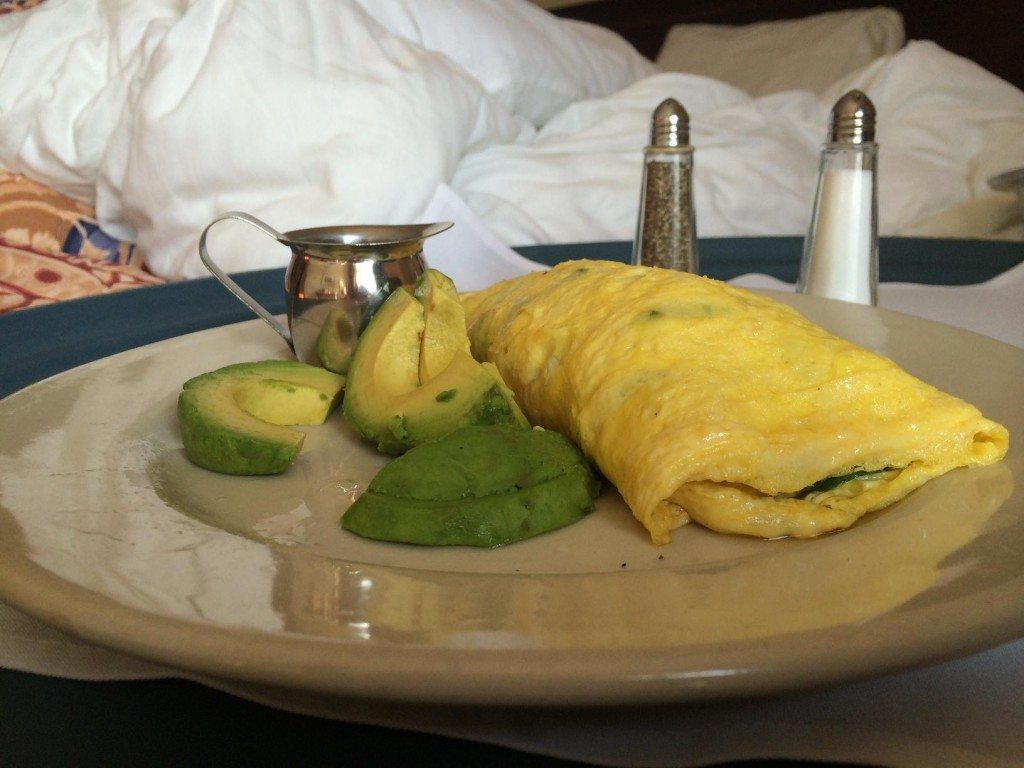

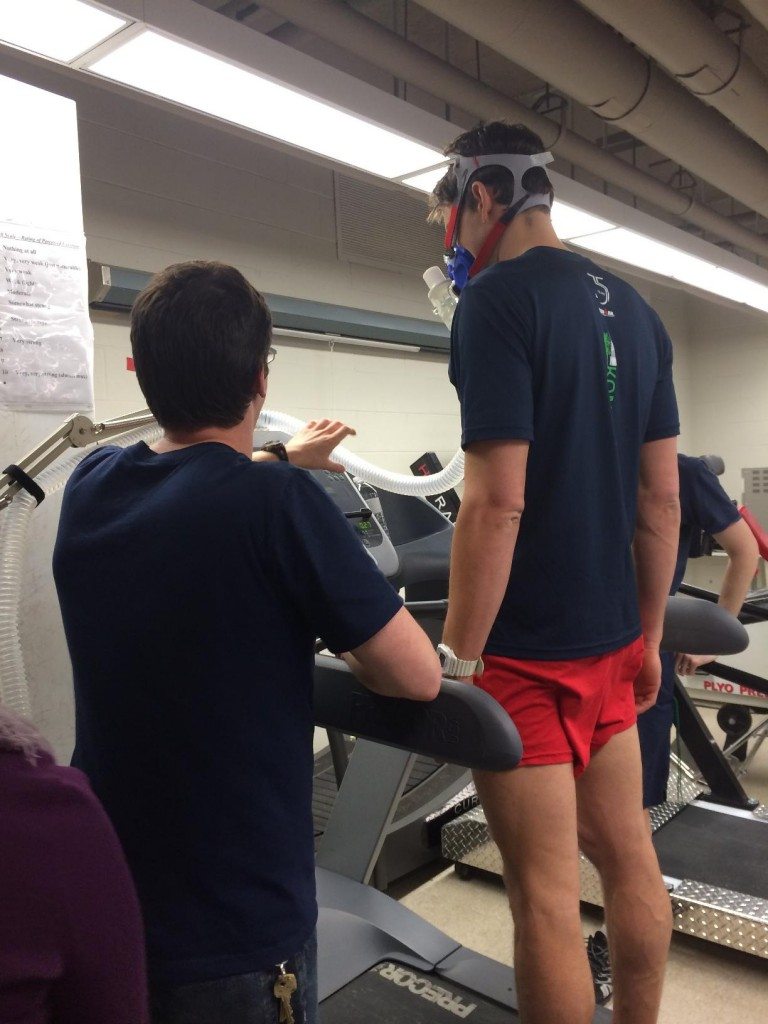
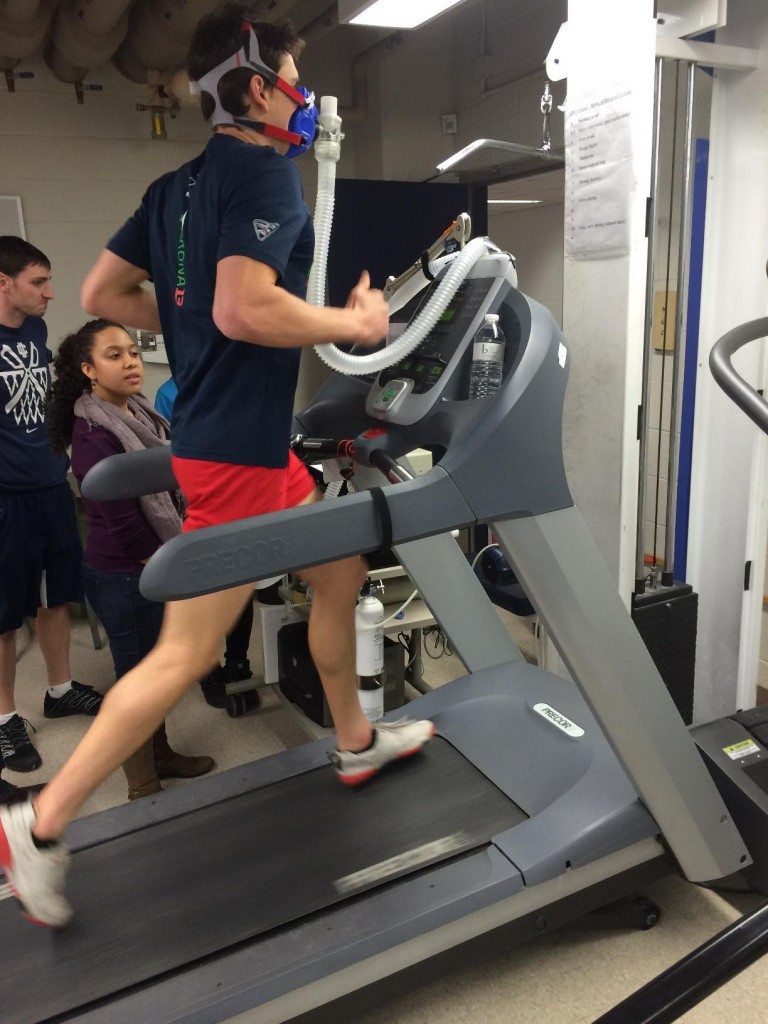
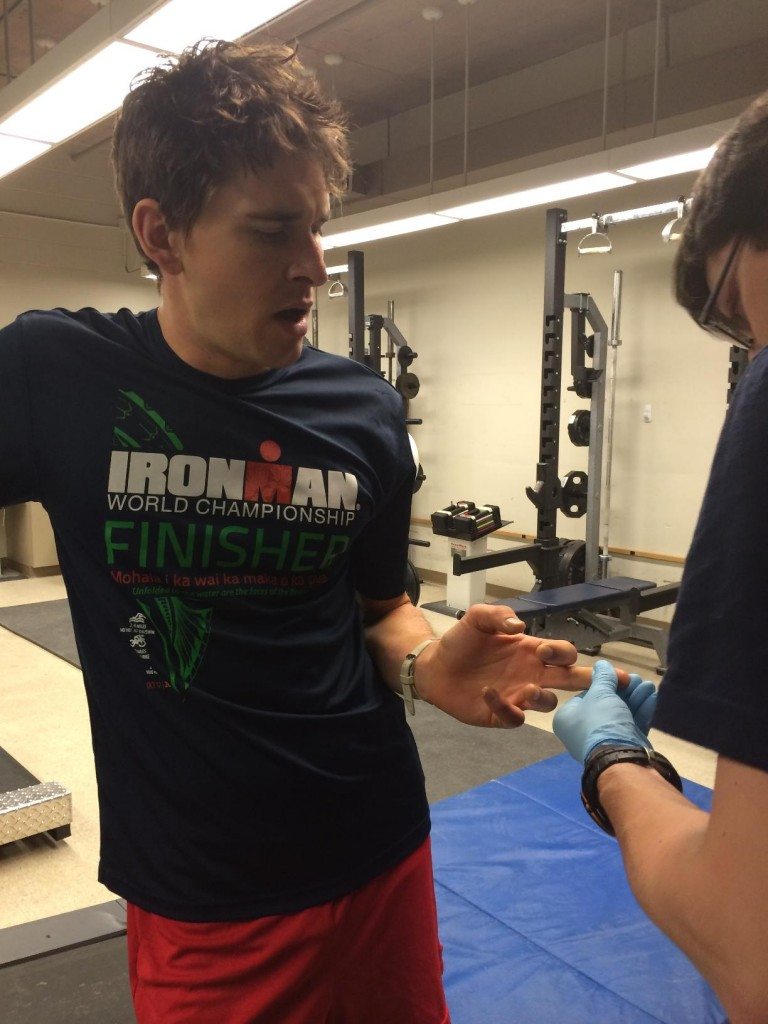






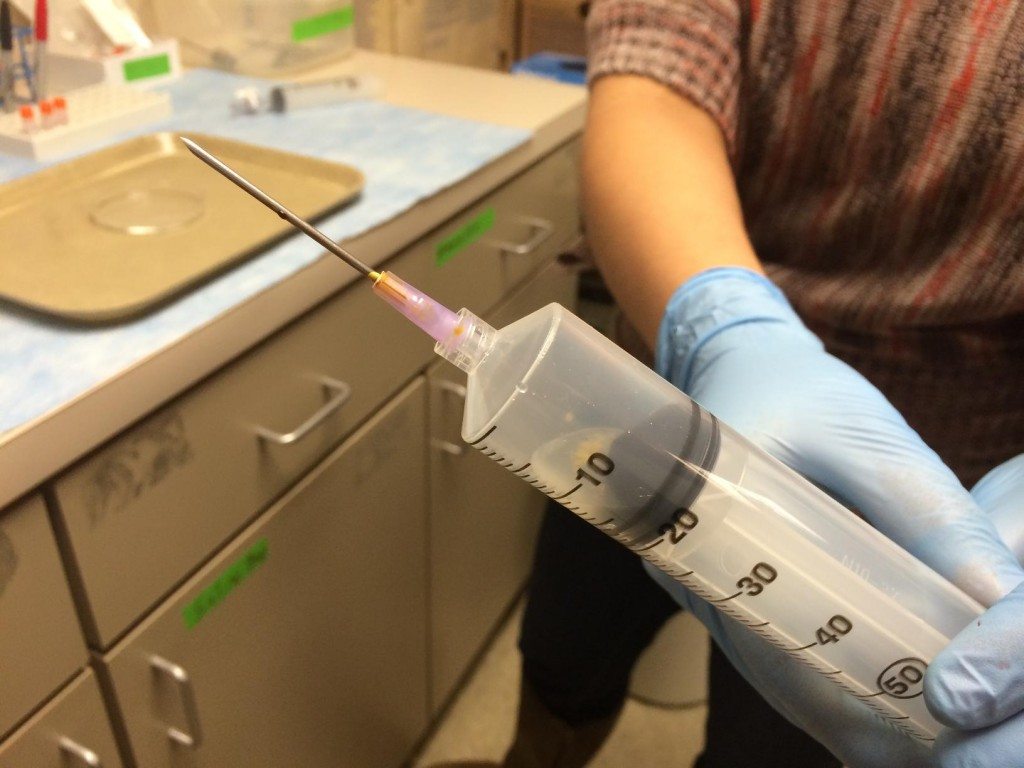

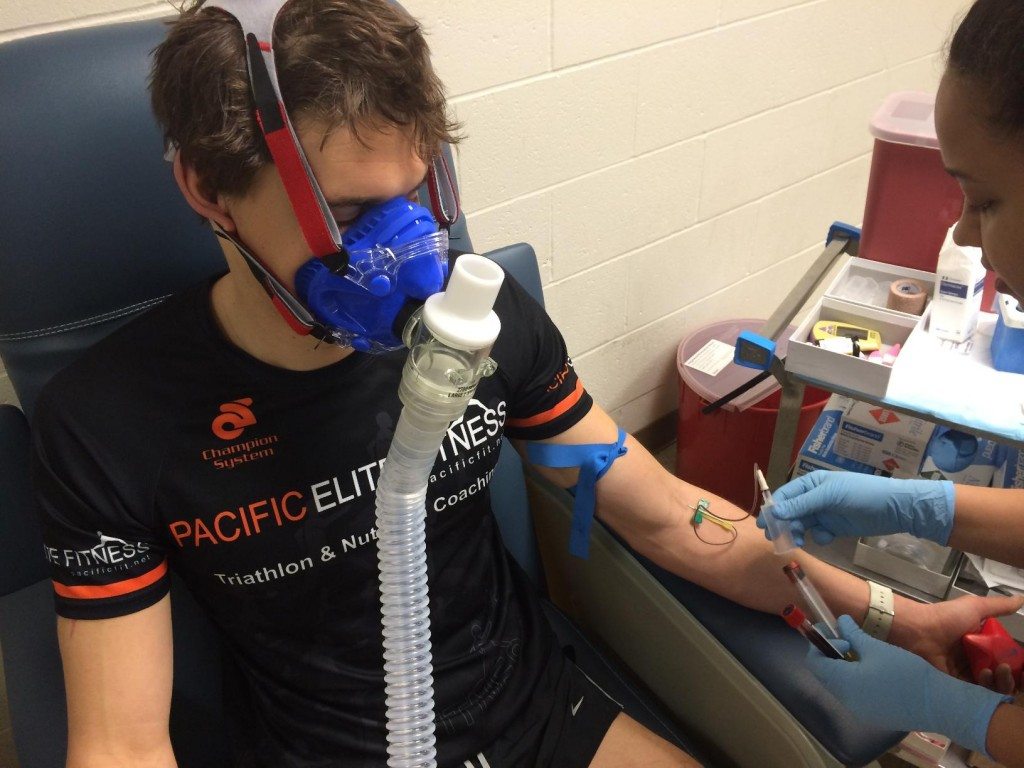

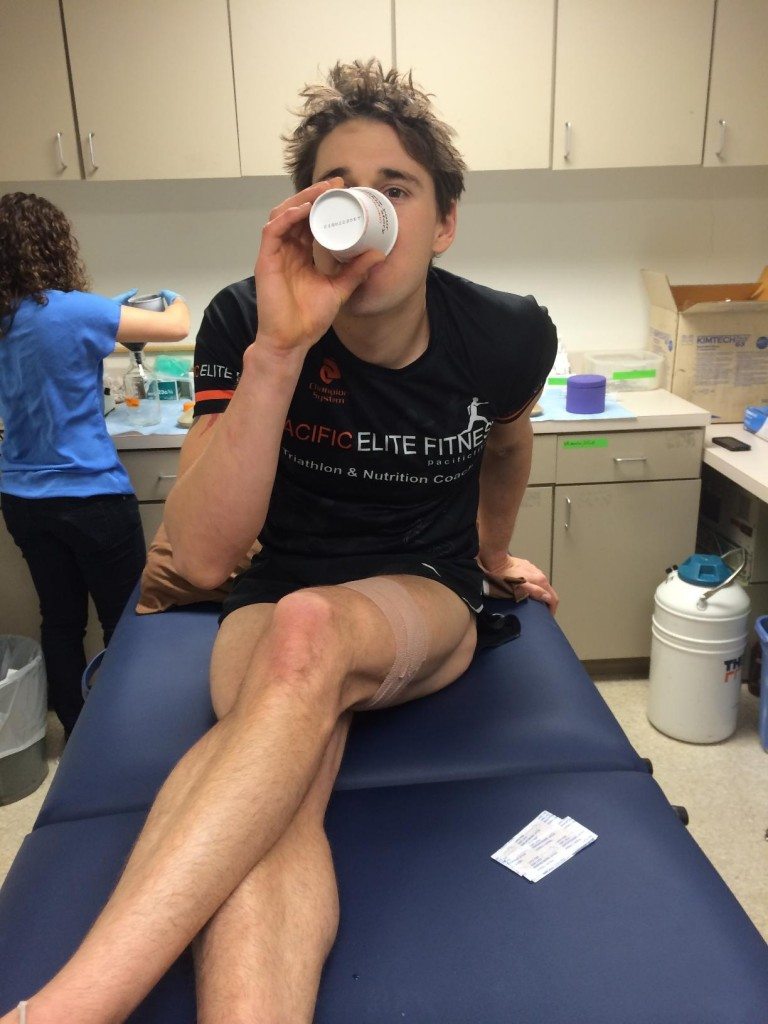
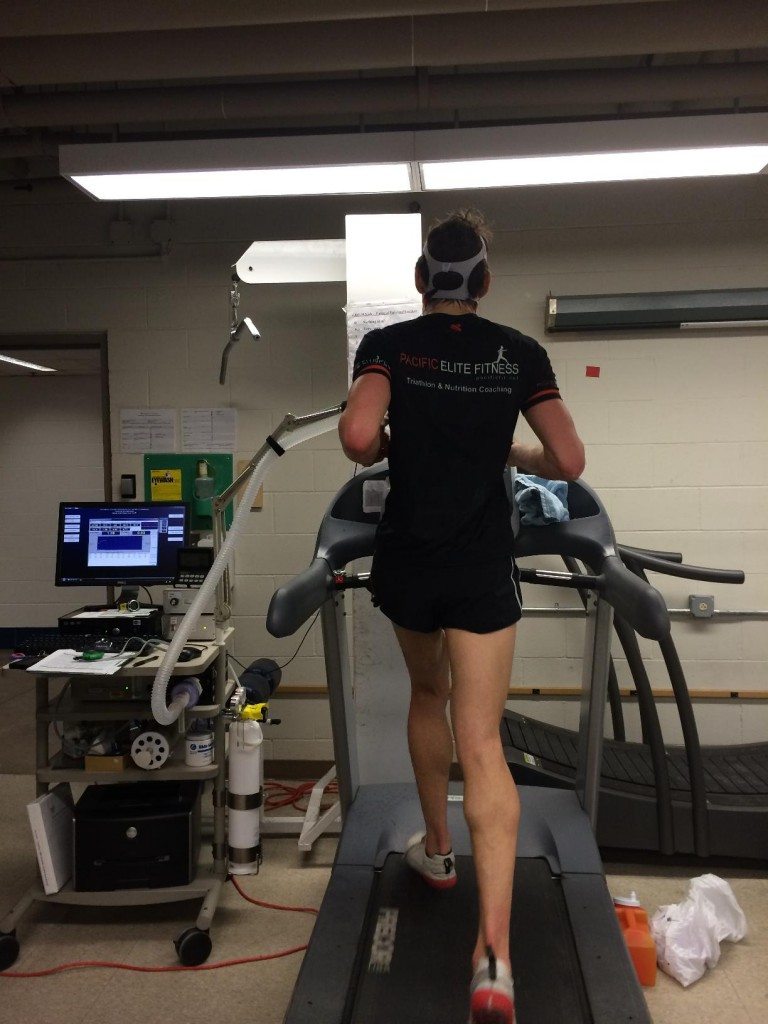

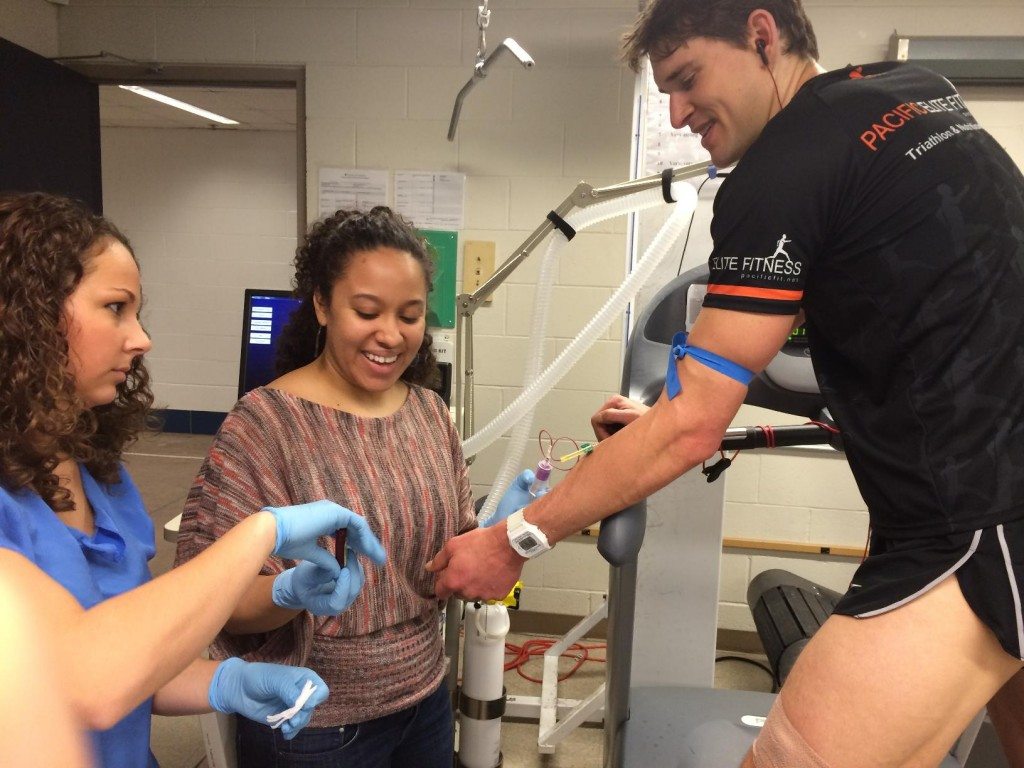
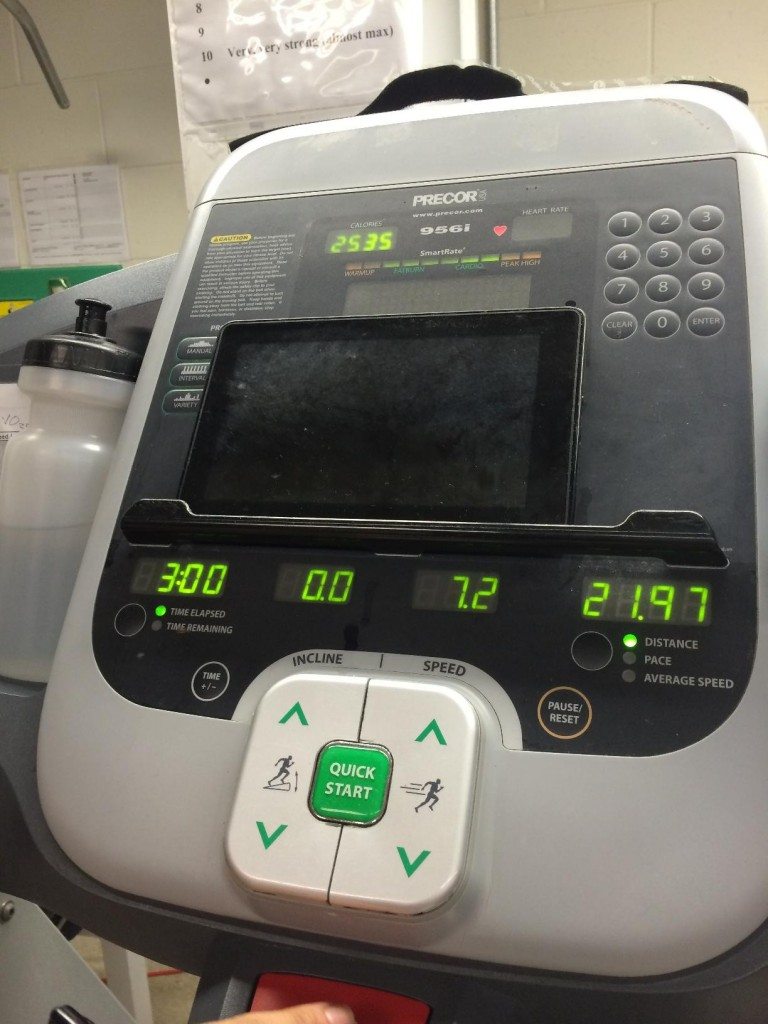
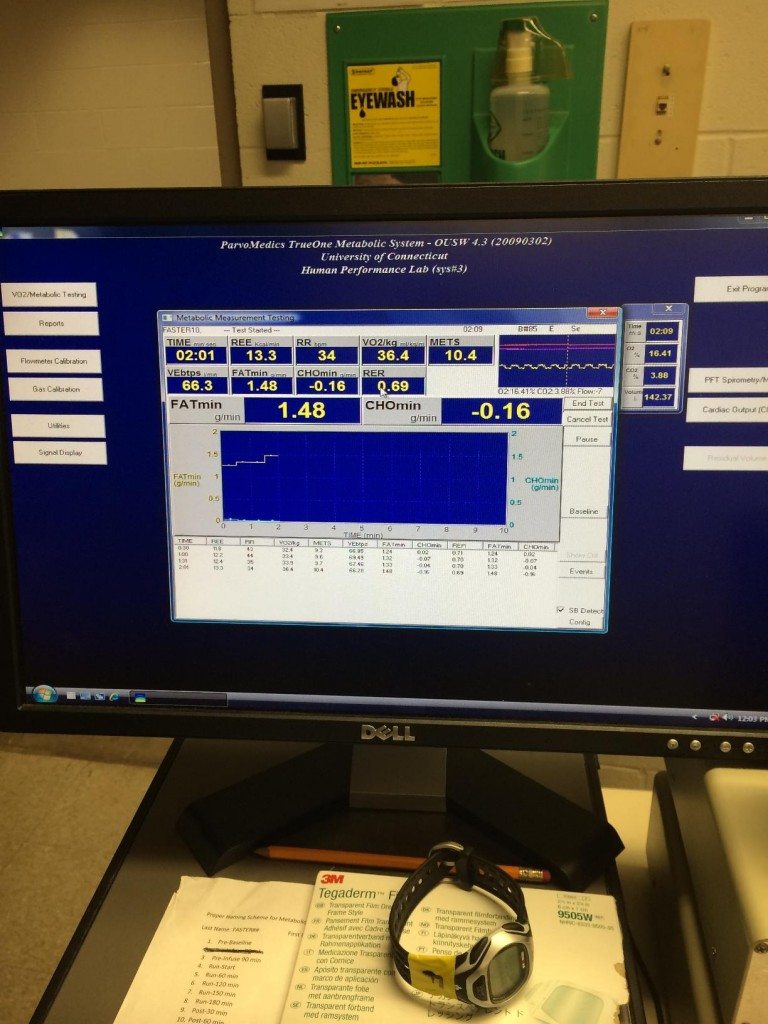
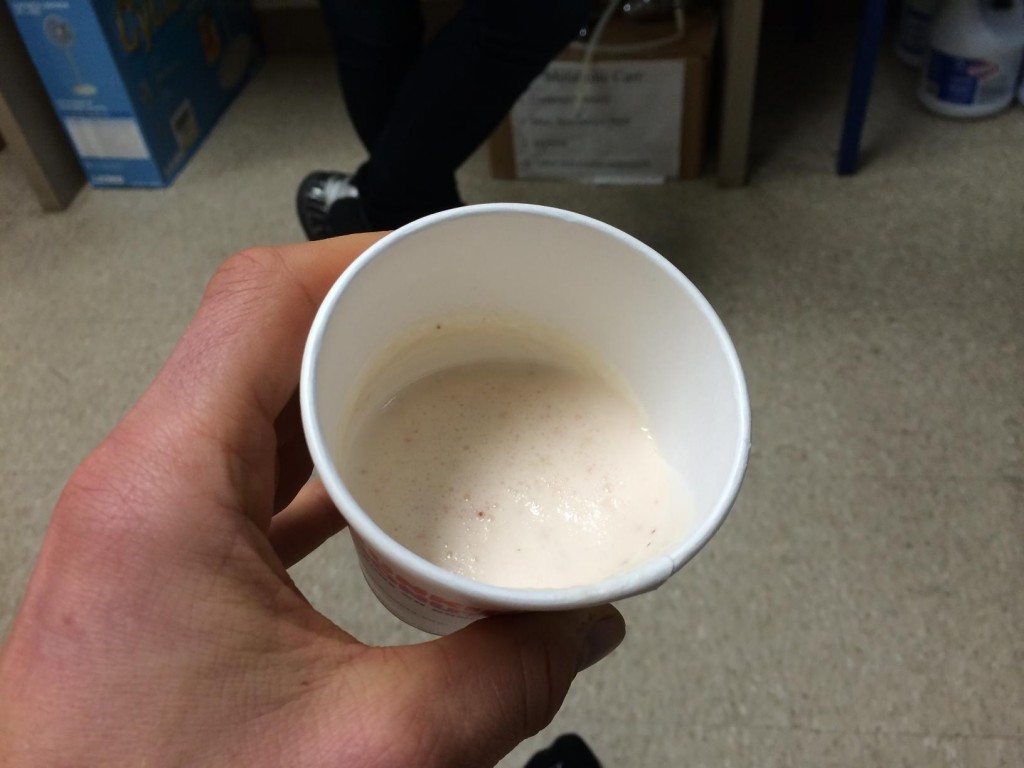
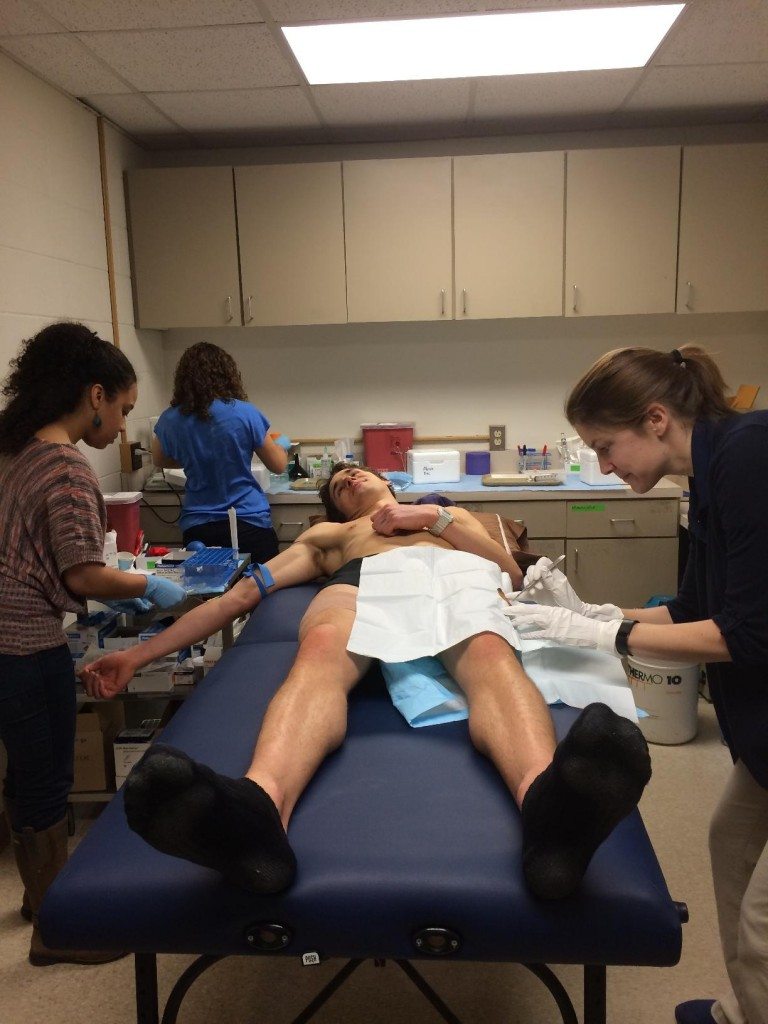
Very good
Congratulations on the article
Amazing congratulations!!!
What a beautiful article Ben, I loved it !!, a mistake I make. Eat lots of carbohydrates and good fats together.
Because of the eggs, I never remove the yolk from them. I use his protein but it comes from fat too.
Ben, your take on this is very helpful in understanding my own VO2max results. I am 57 years old and have been doing CrossFit for 9 months. Previously I was extremely sedentary and weighed 120 lbs more than now. Needless to say, I was quite pleased with my “good” result from the test considering my history.
I have been Very Low Carb for 2 years due to former Metabolic Syndrome issues (I had all of the symptoms – all gone now). During the VO2max test my RER got as low as 0.59. Towards the end, my RER got to 1.11. I am at a low body fat (7.5% per bod pod) so I don’t have all that much fat reserves (12 lbs). One of the studies you pointed towards stated that fat oxidation rates are directly related to body fat percentage so that may explain part of where my body made the fat burning to carb burning transition when it did during the test
It seems to me that as long as I stay out of the top end of the VO2 max range I will be OK but once I transition above an RER of 0.8 my body is looking for glycogen (carbs/glucose) which is doesn’t have much of due to the LC diet. This seems to make the case against glycotic sports like CrossFit for Very Low Carb athletes (without some carbs related to workouts). Or at least it leads to the acceptance that performance will be limited when it comes to the most strenuous parts of WODs. The VO2max test doesn’t let me dial back intensity like I can with CrossFit since it just keeps going up in intensity.
Thanks again.
wow for this article and double wow for your website which is one of the best I found! great work Ben!! Cheers, Helen
Ben, what about athletes who play explosive sports? I play hockey and want to burn fat, but if I dont eat relatively carb heavy that day I have no gas at the game. Has anyone every tested this while doing explosive activity vs plain weight lifting or long steady runs (which are bad for your heart and knees…)
Plenty of studies on this. Start at Ketogains.com. Also look into "cyclic ketosis".
Hello ben,
Came across your articles and am happy to read through and find out that fat does not make one fat but carbs. My questions are
1.have been on this deity for about 5 months now, started with 85kg and currently weigh 70kg, what is the ideal weight I can have.
2.I find it difficult to exercise, hope lack of exercise won’t be dangerous for me. Thanks
Hope to hear from you soon.
Probably the best resource out there for you would be my book about achieving your ideal body type. You can grab that one at http://www.getfitguy.com
Hi Ben
I getting ready to run another marathon(45days) and I feel i’m not in good LCHF mode. How do I get into better LCHF in short time. Reason I say that when I take shake below, i seems to struggle more .
use Glycofuse, Catalyte electrolytes, one scoop of Aminos, and one serving of medium KETO//OS 2.1 version shake.
thanks,
Read this and let me know if you have any questions: https://bengreenfieldfitness.com/2015/12/how-to-g…
HI!
I am quite stuck with my keto diet.
I tried different macros, kcal did reverse diets, refeeds, IF and whatnot
But I dont lose weight anymore
What can I do?
Do I have to keep fat high for max fat loss = nutritional ketosis?
I thought the fat will then also be stored if I eat excess amounts of kcal?
The mTor pathway is protein sensing, right? So what can I do to build muscle and lose fat`?
I count kcal mericiously but somehow doesnt really work or I am constantly hungry all the time.
Any ideas?
There are too many variables to go over here, I suggest you book a consult at <a href="https://greenfieldfitnesssystems.com/ben” target=”_blank”>www.greenfieldfitnesssystems.com/ben and choose 20 or 60 minutes and we'll get you scheduled to go into detail there.
Can you share where that paper by Jeff Volek will be published?
also, are there any studies that you know of about strength and muscle growth?
Read my book Beyond Training https://greenfieldfitnesssystems.com/product/beyo…
Here: http://www.metabolismjournal.com/article/S0026-04…
Ben, I’m trying out the ketogenic diet for a couple of reasons, most being to lose weight and prevent diabetes (family history and personally pre-diabetic at one point in time). I’ve also just started doing endurance training for triathlons and find that when I use sugar-based fuel I get sugar highs and lows. So, now I’m switching and only a few days into it. What I want to know, and haven’t been able to find a direct answer is:
1. Should I be taking in nutrition on my long runs/bikes? If so, what length of exercise should I use as the baseline, and what types of food should I take in? How many carbs should I be taking in calories?
2. Once I’m keto-adapted, will having a carb binge set me back in the ability to burn fat for fuel? That is, will my muscles go back to preferring glucose over fatty acids? When I say carb binge, I mean like having a day where I would eat carbs at every meal or maybe even a few days.
Hey Amanda,
I've written a tonne of stuff on this so I would start by checking this out and then let me know if you have any questions: https://bengreenfieldfitness.com/2013/05/low-carb… https://bengreenfieldfitness.com/2015/02/ketogeni… https://bengreenfieldfitness.com/2013/07/what-to-e… https://bengreenfieldfitness.com/2011/08/10-ways-…
Hi Ben, interesting piece you wrote! Would like you to consider a few thoughts! Is it possible to have a negativec carb or fat utilization? Not really is my guess. In theory if you were using some of the lipolized fat to build carbs, while exercising or vice versa. This would however not at a simple effect on RC. In reality the negative fat count during max intensity treadmill running and similar highly taxing aerobic activities is caused by hyperventilation, causing some extra co2 to be excreted. The negative carb utilization after prolonged exercise in a the carb depleted state, is due to increases oxidation of amino acids residues, where some amino acids give a RC below 0.7.
No doubt that you are a fit guy by the the way, but dexa scannes are not a very reliable way to estimate body fat percentage of very lean individuals, since the 4% possible absolute error is way to large, relative to a fat% in the single digits.
No, in terms of exercise physiology, it is not possible to be at negative carb or fat utilization. Especially at such a low intensity.
Now that was the journey I have never seen in a while. People nowadays are blinded with many myths they just read on somewhere. Some are actually effective, but takes a lot of courage and the hassle of fighting temptation is just not a simple thing to do. I have seen people who hated eating foods that will supposedly boost their diet but they have to consume this and that amount anyway in order to achieve what they want. Your journey sounds tough and I can tell directly that it will pay off in the end. Also, those menus you’ve shown us are just so mouth-watering, not to mention that they can be eaten guilt-free. It may look like that there’s so much work, but if you want an honest and long lasting result, you have to endure it. They say, you get what you give, but if you give this much effort, who knows? You might even get more than what you actually targeted.
Ben,
I am fascinated by this information! I have been Fat and by fat I mean HUGE my entire life. My highest weight was close to 550. Since then I’ve had two gastric surgeries and though they’ve been successful they are obviously not complete answers. Nor didn’t expect them to be. I plateaued at 299 and then got divorced, got depressed and gained almost 40lbs trying to stay the course. It’s like my body loves to be fat! I am still around 330-340lbs. Can’t workout cause of a back and knee issue for now but have every intention of doing so. My hope is that these theories would still work for someone who needs to drop a good 50-100 lbs before they workout hard. Is this so? I’m so tired of this roller coaster that stops at these plateaus and t rally am seeking a life of health. I’m no longer motivated! I’m happily remarried and want to be as healthy as possible! I’d love to hear your thoughts on the average joe who doesn’t run marathons, or the not so average joe who is so obese they can’t really do a strenuous workout yet. I’d love to be your next science experiment! Although some of those tests sound beastly!
you rock
anxious to hear more/adapt
you rock
Ok – “I’m also happy to reply to any questions you have”
Get ready. Strap yourself in.
I know you’ll probably say, after reading my comment here, “you should have a consultation with me” – I honestly can’t wait to talk to you about my lifestyle/training/dreams and goals, but I can’t just yet. It just isn’t feasible. One day, though. When we do, be prepared to talk fast, I’m not sure I can cram everything into 1 hour, definitely not 20 minutes
Secondly, I’m not quite up to ch11-17 of beyond training, but I’m getting there.
Thirdly, I’ll try and keep the language here professional. But you did discuss defecation and urination, so I’m hoping we’re mature enough to talk about that jazz.
In the words of Heath Ledger (go aussies), “Here, we, go”
So on the topic of urination – I just went to the toilet, having not done so for a couple hours, coz I was reading an epic article by one of idols – I didn’t quantify (and I will one day, soon), but very certain I passed close to 3 litres of urine. And this is not all that unusual – I pee frequently or lots, very regularly. I assume this is due to excess ketones, sodium and water trying to escape (side effect of ketosis/low carb) ?????
Is it possible to work out RQ without doing metabolic testing? In other words…..I’m poor, can I still do it? I’ll look into my uni resources (Deakin was rated 47th best in world last year, so, should have something I can use….), but can you give me a ballpark figure of how much it would cost, rough estimate (key word – estimate)????
Reason I ask……….I revisited the concept of glycogen deficit that Peter Attia described in an article, and suffice to say, I’d like to be able to calculate mine after workouts…….but in order to do so, I need to know my RQ……
What are the effects of eating sugar? Now, I deliberately worded that way, coz I think the stupidity of the question (given what we know, the topic here, etc) is quite funny, but seriously – I eat a lot of foods that have sugar in the ingredients list, but have very little carbs………..things like cream, or some meats, where close to 100% of carbs are sugar, but there may be something like 1g of carbs per 100g….what effects does this have on reaping the benefits of ketosis????
are there any studies on ketosis for non-endurance athletes, or ketosis and anaerobic performance (high intensity intermittent athletes, eg, footy, cricket, basketball, soccer, hockey, etc)????
My brother has problems with me saying I “fat doesn’t make you fat”. He sees my gigantic plate of butter, cheese, egg yolks, meat and a big bowl/plate of leafy greens, but focuses on the former, and says “that will give you a heart attack”.
As far as I know (much of this is based on assumption), he has very little education in nutrition.
He studies sports management at uni. I’m pretty sure there’s next to no physiology education involved in that.
Even if there is, we know a lot of the conventional wisdom is not quite right, and he’s probably told “the basics” – eat lots of carbs, especially for athletes, stuff all fat, fair whack of protein, avoid saturated fat.
I’ve tried to explain it in great depth (as I do most things).
I’ve tried to explain it concisely (which I’m pretty terrible at).
How do I convince him it won’t kill me, and it probably WILL do quite the opposite to our father (I’m a lil concerned for dad)??
i’ve found evidence saying beta-hydroxybutyrate is more oxygen efficient than glucose, and also produces more ATP – that is, it has both a greater rate and yield of energy production – I thought all substrates had an inverse relationship when it came to yield vs rate??????
How many athletes (endurance or otherwise) can you name who are using LCHF, ketosis, or any variation of low carb eating????? I can name a few, and successful ones, but it’s not enough to convince my bro or my footy teammates.
I’ve seen evidence for glycogen stores of 50-75% being retained whilst in ketosis – how is this possible, given glycerol and gluconeogensis play very small roles (that came from a Peter Attia article)???? The question has been put to me many a time – you’re not consuming the glycogen, so where the heck is it coming from??????
You might be thinking whilst reading this, that I could really benefit from a consultation. In addition to what I said in this regard at the start of this comment, I must talk to you. I must meet you. Like I said, an hour probably won’t be enough time haha.
Is there any chance you can come down to Melbourne for a biohacking conference or something??? Maybe be a guest lecturer at Deakin University????
I'd love to come to Australia. Obviously you have a ton of questions here that I can address if/when I make it down there. It's actually potentially in the works for next March. Stay tuned. And in the meantime yes, as you alluded to, I'd be happy to help you via a personal one-on-one consult. Just go to https://bengreenfieldfitness.com/coaching. and then choose a 20 or 60 minute consult, whichever you'd prefer. I can schedule ASAP after you get that.
…………
…..did you actually come down here in march, coz if so, and I missed out………..
must
start
following the website
much more oftenly……
oh, btw, I found a way to test my RER. Now have weak scientific evidence (nonetheless, evidence) that kebabs induce fat burning.
which I knew all along. Come on, it’s a kebab, it’s like, if superman was a food…..
Great Article. I just did a VO2Max test with similar values as the LC group in the Faster group study. FatMax of 1.35g/min at 73% of VO2Max and RER of 0.73. I was only into a ketogenic diet for a week when I did the test but trained for 5 months according to the Maffetone formula. In that time I ate how I liked and I like fat and carbs so I would call it a high fat – high carb diet. What amazed me was the fact that I still burned fat at 98% of VO2Max (5g/h contributing 12% of total oxidation, RER 0.96, HR 177). I just read the full Faster study report and it proofs it clearly that fat-oxidation works better with high fat diet (2.6 fold if I remember it right compare to low-carb guys). Gaterade won’t like this at all. Sell your shares. The next big question around fat – oxidation will be the intensity and how to ramp that up.
interesting if the high fat diet argument applies to more sedentary people. I doubt it but you never know.
there’s prob also various genes/alles that predispose certain people to gain more weight from carbs
interesting horizon tv prog on bbc recently. showed that v hard to eat JUST fat (cream) or JUST glucose (sugar) – we self regulate consumption. …the killer was the combo of the two that keeps us eating. part of that might explain why high fat could work???
Wow, you may have just changed my life outlook. I was just told yesterday that I am pre-diabetic with my fat and cholesterol both VERY high. No doubt I love carbs but my doctor says I need to drop a LOT of weight so no more carbs. I got depressed really bad yesterday. Losing fat has always been a hard struggle for me. Since I have basically been on a high fat diet, I am pre-prepped for trying to work this method of fat loss.
I am now ready to drop the depression and take action. The sheer torture that you subjected yourself to in order to help others gain from your experience proves the awesome character you are. Thank you. You have given me a reason to smile and motivate myself on what is undoubtedly going to be a long journey to lose weight.
Thank you Ben.
will we ever see the rest of the results?? surely all samples have been analyzed by now.
Yes, this study was published. We discussed in podcast. http://www.metabolismjournal.com/article/S0026-04…
I am by no means your best customer so wouldn’t expect you to cater to me, but I don’t listen to podcasts, I need written info. Aaand in the last paragraph you said you would add the results to comment section as they continued to pour in…
Hi Ben,
I know this is an old article, however, I am really interested in this field of study.
I have a quick question though, I have been told that I have high Cholesterol, Does this mean It would be dangerous to use a high fat/low carb diet ? Sorry for the random question, but I have struggled with weight loss and didnt know if this could be a hindrance.
Thanks for your time
We have covered this a ton in previous podcast but short answer is that unless you have a specific gene called ApoE gene responsible for potentially causing cholesterol to become athersclerotic, a non issue. You can read WAY more about this (and I recommend you do) here: http://www.cholesterol-and-health.com/
Thank you so much for your response.
Have a great Xmas!
I have not looked through all the comments, so just guide me to that comment if this is already answered. Do you know if similar studies have been done on all women? I wonder if a high fat diet in relation to fat loss would be different for men and women? If you have any literature on that I would be very interested in checking it out. Thank you!!
Interestingly, yes, studies like this <a href="http:// (http://www.ncbi.nlm.nih.gov/pubmed/17425444)” target=”_blank”> <a href="http://(http://www.ncbi.nlm.nih.gov/pubmed/17425444)” target=”_blank”>(http://www.ncbi.nlm.nih.gov/pubmed/17425444) have been done on women showing that fat burning capabilities vary based on the phase of your cycle, with less sensitivity to insulin during luteal phase, meaning a need for more fat, less arbs during that phase. There's also a very good resource out on the difference in nutrient utiliations in men vs. women during exercise that I talk about here: https://bengreenfieldfitness.com/2013/07/how-t…
Did you eat nuts and seeds regularly as part of this experiment?
No. I averaged 1-2 servings a day because of the high omega 6 fatty acid content.
Freaking fabulous!! I rarely comment, but have been following since we met with Timex in Kona and this is so the kind of thing that I LOVE! I am all about doing the crazy tests to learn more. Can't wait to see the results!
Hi Ben,
From the table with the data on fat/carb oxidation, it shows ca. 0.1g fat/min before the run. Assuming that is close to REE for you. Would it be correct to say you burn 0.1g/min*1440min=144g fat per day as REE?.
Resting metabolic rate test (rmr test) measured this. Available at most hospitals/ sport performance centers and is indeed accurate way to approximate total daily resting fat oxidation. But doesn’t measure exercise so I have to account for that too!
When is your book going to paperback?
Already on paperback! Go to http://www.beyondtrainingbook.com
Amazon only shows hardcover and Kindle.
Ben,
Great stuff. I have been low carb/high fat for nearly four months now while in training for half and full distance triathlons. I was fortunate enough to have a VO2 max test done on the treadmill a few weeks back. My results were shockingly similar to yours and I am incredibly excited to race in a week and a half knowing that I've really fat adapted. The irony is that I had that test done in Ed Coyle's lab down at UT – who advocates carbs on carbs for exercise performance.
Results here: https://www.dropbox.com/s/tpkbv3jqeltqnud/Paul3-2…
All the best in your training and future endeavors – I'm excited to read the study in its final form. I have firsthand experience with the work that Volek's lab publishes and they are incredibly thorough.
Cheers.
I've followed your food pryamind diet for about 70% of the time for 4 years and have gained 1.5 inches on my waist and gained 12 pounds. I've followed your diet 100% of the time for up to a month straight at times and overall I've seen no weight loss and no change in waistline. I've seen waist and weight reduced at times and other times I've seen it increased. Stephan Guyenet cited a controlled study where people were fed strictly high fat or low carb and their was fattness change varied widely. Therefore, I think we can more safely conclude that not everyone will lose fat on a high fat diet.
There are of course other factors at work. Hormones can play a large role in how well any dietary changes will effect you. Take a look at this – https://bengreenfieldfitness.com/2013/12/how-h… and this https://bengreenfieldfitness.com/2015/02/how-t…
My cortisol and thyroid were normal when I checked them a year and a half ago. I have not checked my testosterone. I'll check out these podcasts and see what else I should get checked and/or get them checked again.
I'm going to replace you with Stephen Gionet for fat loss diet recommendations. He better understands the science and makes more accurate conclusions from the research. I've following you and Dave Asprey's advice for 4 years and seen an increase in weight and fat. Reading the studies that Stephen cites, it makes sense as to the results I've seen. I've seen other improvements with my health due to eating high quality fats, but not fat loss.
Thanks for your honesty. I sincerely hope you find what you are looking for.
Stephan Guyenet shows studies that show that fat diets are just as fattening as carb diets. The exception is when the diet turns ketogenic. I tried a low carb/high fat diet with calorie restriction while doing 2 high intensity workouts for 6 days. I gained .5 inches around my waste. This diet did not make me lose fat.
It's easy to do a LCHF diet incorrectly. Take a look at these pages for some help https://bengreenfieldfitness.com/2013/07/how-m… and https://bengreenfieldfitness.com/2011/08/10-wa… that should get your going in the right direction.
I ate most everything from your food diet recommendations. The articles you cited didn’t show controlled trials where we can make definite conclusions on which variables affected weight. I’ve been eating mostly low carb with yours and dave aspreys recommendations for 3 years and gaiNed 2 inched on my waist and gained 12 pounds.
I noticed that you ended up in the high fat group of this study. Did you have a choice? If so, this study is not randomized and that weakens the conclusions we can make from it.
A large component of the study was to compare fat adapted athletes against carb dependant ones. It takes time for your body to adapt (either way) so it couldn’t technically be randomized and still work.
why not?
couldn’t the ones chosen to go keto for 6 months be randomised???
And something I wondered about……did you do pre testing, or just testing after becoming fat-adapted??? If the former is true, then why havent you mentioned the test results of before the 6 months?
due to the nature of this test, pretesting was not possible, although that would've been quite interesting. They simply had to choose athletes who were already at hearing to a keto diet. I can tell you from my own blood testing that is vastly reduced my blood sugar levels and HbA1c switching to low carb/keto.
basically, why couldn’t it be done as an RCT and not a cross-sectional study?? Just too much cost (financial or otherwise)?
Very impressive.. I’ve been on this keto diet for more than a month now and I have to tell you, it was hard at first. Craving cereal, milk, all the good carbs. Until I actually went to try and eat a certain food Im not supposed to, didn’t really taste that appealing to me. Such as certain chocolates that I used to love, seemed disgusting. Lol I’m glad I came across this study and how you broke it down so simple for all to understand. Just one Q, are you continuing this LCHF diet? If so, any updates on it? Would be happy to hear how its going for you! Thanks again for sharing your experience!
I base my diet mostly off of this book https://bengreenfieldfitness.com/2013/02/perfe… which makes it LCHF. I's going extremely well for me and my family.
Ben, this is a great read – I keep returning to this article. I just want to ask what, if anything, you've changed in your diet since you did this test? And if yes, why?
Primarily, I've switched from full on 80-90% fat and extreme carb restriction to 50-60% fat, 20-30% protein, 10-30% carb (carbs fluctuate depending on days activities). So I'm more in cyclic ketosis that strict ketosis.
Hi Ben,
What were the final results of the experiment?
Heh…preliminary results are only just now rolling in…welcome to the world of peer reviewed research…I'd say another few months before results are fully published…
I didn’t find the whole study but here is a pretty good outline of the results. Very interesting.
http://www.metabolismjournal.com/article/S0026-04…
Thank you Ben for a super interesting experiment! I will take part in a multi day cycling event and was wondering how to optimally fuel for this? I used typical high carb energy gels at the rehersal training weekend and felt all sugared up and bloated on the evenings of those days. Your blog post on alternative less-sugary energy gels was helpful, but are there still more natural, high-fat energy sources to take on the ride? We will ride 150-210km each day during 7 days. Thank you and keep up the good work!
Have you seen this post? https://bengreenfieldfitness.com/2014/06/natur… It should help. Also take a look at this https://bengreenfieldfitness.com/2013/01/episo… (look at Alexander’s questions) and Khoo’s question here https://bengreenfieldfitness.com/2012/07/episo…
Do you attribute any of these results to the nasal breathing prescribed by Douillard? I'm thinking that, since it keeps your brain in a less stressful state during exercise, it might also have a corresponding effect on your heart rate and metabolism, such that you still rely mostly on fat at higher levels of intensity.
Hi Ben, do you think a ketogenic diet and being in a state of ketosis would be better than “traditional” diets for events staged over 4 hours at 150-160bpm, but with a small break between each couple of hours? Cheers and keep up the epic work :)
Yep. Actually for anything that exceeds glycogen depletion volume, which would be 2+ hour time frame, it would be appropriate and if done properly, superior.
Just started reading your book, plan to implement for endurance training (Ironman late fall). Given the results of these tests, is there anything in your book that you would revise?
Nope…this stuff forms the foundation of my book!
While eating LCHF, macros aside, can you talk about fat intake relative to fat burning for someone looking to lose unwanted body fat? Specifically, if one is eating high fat, is there such thing as too much fat? If one consumes more fat than the body needs will it store the extra fat consumed? Or if there is plenty of dietary fat available for energy demands will the body burn that instead of taking from fat stores?
That's a complicated question. It might help for you to read this https://bengreenfieldfitness.com/2013/07/how-m…
So in podcast episode 283 you said lactic acid doesn't cause the burn, but here you state, "they should theoretically produce less lactic acid, resulting in less burn and less discomfort during exercise – a convenient biohack indeed…"
Can you clarify?
Semantics. A byproduct of lactic acid formation is hydrogen ions. But the average person, if I use that description, would not understand that phrasing. Only my extremely smart podcast listeners like you Ryan!
Interesting article Ben – one question though . Does a high fat diet improve performance in endurance events 2+ hours long?
We know it can improve the % of fat burnt during exercise but can it improve performance in the marathon or ultramarathon?
Well, like I said in the article: it can massively improve your health and not limit performance in the least.
Hi Ben
AMAZING set of articles there… thanks so much for sharing!
My question concerns the best post workout meal/ shake.
Do you have a recommendation for a time period you SHOULD eat within POST workout?
And is it best if the post workout meal/ shake has a high protein percentage or a high fat percentage?
As a note, I’m vegan and currently eat a high % protein shake (with some carb content from banana) within 10 – 30 mins of a workout.
Does this seem like a good plan or is it better to wait a longer period of time to allow your body to keep burning fat after a workout?
Thanks again!
Take a look at this post https://bengreenfieldfitness.com/2013/07/what-… and check out my beyondtrainingbook.com, I cover this very thoroughly in there.
more great info – thanks!
Hi Ben,
Did I miss the content of the post run shake somewhere?
About the pre-run shake. Why did they choose olive and walnut oil instead of something like coconut or mct oil? Seems like the latter would have made more sense for the 3hrs.
Also how would you rate the effort / level of perceived excursion? How did they determine what speed to set the treadmill at? Was it based on your VO2 max test?
Thanks.
The post run shake was IDENTICAL to the pre-run shake. The olive and walnut oil choices will be explained in the final research paper, but it is a great question and one I was wondering myself. I ran at about a 6-7, but it felt like a 7-8.5 by the time I finished the test, and my exertion was based on a % of my VO2 max test.
Thanks!
Hi Ben
So what’s the bottom line on muscle depletion using this approach? You established that the fat burning is efficient, but it’s not clear whether the body also tries to burn muscle aswell/first. Did you get any data there?
That is something we'll know for sure once the muscle biopsy data is in!
Ben it’s a sensational headline but is it really true?
“However, what if we could actually prove that eating a low-carb, high-fat diet for a long time, becoming fat-adapted and even avoiding carbohydrates during the one time when we’re most encouraged to consume carbohydrates (during exercise…could actually turn you into a fat-burning machine without losing a shred of performance capability or causing any metabolic damage?”
Didn’t your Kona experience prove that it is possible for a fat adapted athlete to perform really well on less carbs but you still need carbs to perform at a high level? You bonked after about 7hrs and decided that you should fuel with more carbs in the future.
I don’t know of any high performance athletes that will race an endurance (greater then 2hrs) event without carbs. There are lots of slower people doing it but not the fast guys. Guys like you and Sami have proven that it’s possible to go fast on smaller amounts of carbs per hour (100g to 200g) but not do away with them altogether.
Actually, Andy – I didn't bonk at all in Kona. And in Canada, the issue was not a high enough intake of amino acids, and a need for high glycogen intake ONLY FOR THE LAST HOUR OF THE EVENT during which I reached carbohydrate oxidation levels that were very high, in the presence of having depleted glycogen levels after a full day of Ironman racing. Pretty unique scenario there. I never ever have recommended doing away with carbs altogether!
I know I’m commenting on everything here, and trust me, I’m one of the first guys to say “it’s LOW carb, not NO carb”
BUT…..
……doesn’t tim noakes pretty much say to do away with the carbs all together? I’ve heard/seen him say the human body does not need 1g of carbohydrate. I know you respect Tim almost as much as I respect you, so…….thoughts?
I think that that approach only works for the generally sedentary population or in folks not engaged in very glycolytic efforts.
right, makes sense. again, sorry for late reply. thanks for that.
I’m super keen to see if you’ve interviewed Tim.
Hi !
i’ve read with great interest your article and i have some questions. I’m a french physician involved in critical care and anesthesiology and i’m fond of sports physiology and nutrition. I’ve also done a lot of tests with myself and i feel pretty close to your behavior :)
The questions :
1) do you have more datas about your VO2Max test ? i mean the graph according to Wassermann’s usual layout. Where are your ventilatory thresholds (much more important than the VO2max figure)
2) It takes a long time to get the benefits of the LC diet. What happens if you rise your carbs input, when do you lose your advantage ? quickly or not ? I mean do you have to stick super seriously to the diet because a good french baguette will destroy your optimized fat burning pathways ?
3) What do you eat on ultra events ?
Thank you
1. The full VO2 Max test pdf is there and greater details will be available when Dr. Volek releases the study – I unfortunately don't have access to ALL the data yet! 2. If i increase carb intake (e.g. go out for a meal and have lots of potatoes, rice, etc.) it generally takes me 48-72 hours to get back into ketosis; 3) during ultra events, I eat like this: https://bengreenfieldfitness.com/2013/07/what-…
With all the talk about the importance of the gut microbiome, I'm very interested in hearing about the results of the stool sample when on a ketogenic diet.
(and whether you were regularly taking probiotics or fermented foods in the period prior to this test.
Are results available yet?
Thanks…great work guineapig!
Yes, I eat fermented foods every day, and travel with probiotics! I also do quite a bit of GI testing…just finished one actually, and am recording a podcast with my doc during which we go over the results! I do the GI Effects panel from direct labs: http://goo.gl/JJoOT
Ben, I now have a square a red tape opposite my indoor trainer. This will remind me that Ben Greenfield is a badass and I need to quit my bitching.
What are the implications for natural physique athletes and natural body builders? I saw the picture in Part 1, but I'm curious if high fat and low carb are also optimal for building muscle.
Thanks!
Did you read this article? https://bengreenfieldfitness.com/2012/05/can-y…
Yes I did! Another great read, but do you have other links explaining muscle repair and growth with carb utilization vs fat utilization?
I'm not a dietician or anything close to that! Just a common gym rat looking to reach his genetic potential sustainably.
Thanks!
Not aside from the research study I cite in the article…keep me posted on what else you find!
This isn’t a research article, and I don’t necessarily agree with its enthusiastic claims, but it sounds like its on the same page as what you’ve been writing about (except high protein instead of moderate)
http://www.bodybuilding.com/fun/anabolic_nutritio…
You also recommend a refeed period like this article, right? Is your recommendation also 36 hours?
2 thoughts: 1) BIG difference once you add in high protein, due to gluconeogenesis and conversion of proteins into sugars, which can knock you out of fat oxidation; 2) I recommend refeeds on the most active days of the week, and for optimal hormone balance, that really shouldn't be much more than 1-2 days per week that you're "destroying" yourself with a workout. For me, it's usually Saturdays.
I found this article (not an academic journal): http://www.bodybuilding.com/fun/anabolic_nutritio…
Though I don't entirely agree with some of the claims, it seems close to what you've written about, right?
Also, I've read on a few different websites that carbs should be as low as 50 or even 20g a day, but that seems almost too low for someone (me) training 5 or 6 days (and 1.5 hrs each day) a week. Sub 200 makes sense, but 50 seems too low. What are your thoughts on this?
Thanks again!
Great article, Ben, discussing a new and exciting field.
I have found it frustrating and confusing deciding "who is right" in the ongoing media campaigns between the various diet methods.
For example, comparing this to a Dean Ornish type of protocol, which I would think is indisputable in its effectiveness in reversing disease. Many plant based endurance athletes talk about having amazing recovery abilities, and new energy when adapting to that sort of plan. Likewise, you here, and others have spoken of lower inflammation, body fat loss, and enhanced fat-burning capabilities when changing to a high fat based diet.
What to think of all of this! How can BOTH work?!
You have alluded to it in Part 1 of the article, and in past podcasts: Get rid of the sugar and refined carbs!
If you choose a higher-carb, but plant-based diet for moral or ethical reasons: GREAT, do that, it will work for you!
If you choose a high fat, lower protein and low carb diet: GREAT, that will work for you, too!
Just do something to get off the standard American diet.
It makes sense that we as humans have both pathways to survive. I would imagine that this fat adapted one allows us to make it through cold tough winters.
I appreciate your research and am excited to see more of your findings coming soon. This is all refreshing.
Thanks for the fascinating post. I enjoyed it even more because I actually graduated from the UConn Exercise Science program in 2009, with Dr. Volek being my advisor in the department.
Ive got some comments and questions about Bens recent post and in particular the VO2 max test.
Hopefully you can help or pass along the comments/questions. Im having trouble relating the 3 hour TM results to VO2 max test and the significant differences.
Ben states (italics):
I consistently burnt far above 1g/min of fat during the entire run, and often went above 1.5g/min, which is unheard of (notice the -0.16 g/min carbs in the photo below…I was burning so much fat the carb count registered as negative
1. The negative was in the FAT columns not CHO column during the max VO2 test.
2. Seeing as his numbers from the VO2 test were less than 1 up to 38ml/kg/min and DECRESASING in %fat as intensity increased at a VO2 above~38.0ml/kg/min. Was the entire 3 hours at sub 38ml/kg/min VO2? Why would they not correlate.
During the majority of hard, sustained exercise, I was burning close to zero carbohydrates.
1. This is totally opposite the VO2 test, and impossible. During the “hard work” of the max VO2 test he was burning >1.33 g/min of CHO, his %CHO was increasing, and his %FAT was DECREASING. For the first 2 minutes of the VO2 test he was nearly zero of CHO in g/min.
I continued to burn nearly 100% fat and 0% carbohydrate for hours after the run.
It has been researched that post cardio there is limited to no EPOC, one would expect you to return to 0.7 RER/RQ.
Also RMR blood draw at the same time-bad form. People have white coat syndrome, not that Ben does, but I guarantee his HR and BP increased during the draw-altering his RMR/BMR.
Some would also argue that Ben actually performed a metabolically sub-max VO2 test. A RER of >1.10 is widely accepted as a VO2 max test. Other criteria are HR-not provided and volitional fatigue. In my experience I would also expect a higher RR rate than 44-57. I digress.
Thank you
Frank
Frank – there were TWO tests here: a VO2 max test (in which total carbs burnt would by definition be higher due to the gradual increase to 100% intensity) and the subsequent 3 hour treadmill test (during which you will see that fat oxidation is extremely high, much higher than any textbook would predict). Hope that helps!
Also, my HR and BP actually dropped dramatically during the draws. As a frequent lab guinea pig, I've trained myself to use heart rate variability to consciously drop HR by 10-15 beats.
Correct Frank. I think BG was a little undercarbed when he looked at the results.
I ran a 2:48:07 marathon 2 weeks ago. On the road. BG ran 22 miles on a treadmill which is VERY slow considering he rates himself as a 'gun ironman competitor'.
If his high fat diet was so good, how come he ran so slow? How come the 2:05 marathoners LIVE on corn and sugar and very little fat?
I agree Frank, BG made some glaring errors in this 'study'.
Ben never said this was to be at the same speed as he would run a competition marathon (or ironman.) I don’t think there’s any doubt that many people run on sugar. The point was, that sugar is very damaging to the body, so can we perform with a high fat diet and burn fat instead and protect our bodies from the ravages of sugar
are you actually fair dinkum?????
whilst I hate the fact you’re an Aussie, I do love that you’re a crow eater, and not a vic. So we can safely say there’s no vics with as little intelligence as you (at least not as well known as you).
BG was on A BLOODY TREADMILL!!!! YOU KNOW THOSE THINGS ARE SET AT A CERTAIN PACE, RIGHT????
when has he openly said “I’m a gun ironman competitor”??? Do you know the bloke personally, or something??
If we’re looking at observational data here, how come the best cricketers in the world (Dave Warner, Steve Smith, Usman Kwahja), some of the past best cricketers in the world (Michael Clarke, Mitchell Johnson), the best footballer in the world, and arguably best ever (Gary Ablett Junior), and the best basketballer world (Lebron James) LIVE on high fat foods???????
Please elaborate on these glaring errors!!!!!
(……elaborate means to go into detail…….)
Frank confused the two tests (the VO2max and the 3h treadmill test). There was nothing “correct” in his comment. This is not to pick on Frank, it’s just an observation (no, that does not imply a causitive link, mate ;) )
Excellent study. I too, do 3 hour long Mountain Bike rides in steep, hilly terrain, riding fast enough to keep it interesting and fun…completely on an empty stomach. I eat lots of fats and protein and carbs, as the rides are quite intense.
Thanks,
Your 10 min increase V02 test showed me what I was looking for. Its very important info.
Wow That's Wack!
Selling all Gatorade Stock NOW!
Thanks for your contribution to "Keeping it Real"
This was thorough and entertaining! Thanks Ben. I am currently reading your new book, so I hope I am not being premature with my question. What recommendations can recommend to women who are athletes, yet want to become better fat adapted athletes, yet already have underlying thyroid/hormone issues. I follow Peter Attia's work and tried a similar protocol and gained 10 lbs!
Thank you!
Kristie
Brilliant article! Well written and incredibly detailed.
Ben, you are awesome! Thank YOU for doing this and sharing all of your results. You're pretty tough and I applaud you for running three hours on a treadmill. I look forward to reading more of the results!
I am interested in hearing how the females did….. and how many carbs they ate per their diets….. so is that like 200g carbs a day for someone who eats about 3,000 cals?
I got goosebumps when I read, "Consider the textbooks re-written!"
Fabulous! What a neat thing to be a part of. I can't wait for the rest of the data to come out, and your explanation of it all. Thanks, Ben!
-Celia
Ben…you've really outdone yourself this time. Brilliant account. I'm not sure how you did it…but you almost made the story exciting. I was hanging on every word.
By the way…I have your new book and it's great. The only problem is that it's more like 10 books all in one…hee hee. I read a little every night.
Thank you for all your good work…
Paul
Very interesting article. Good stuff as always. I'm curious what your diet was leading up to the experiment. I know leading up to Hawaii you were doing the sub 5% of calories from carbs. But it sounded like afterwards you may have bumped it up to a more manageable 20%?
Do you think results like this can come from the numbers you recommend in Beyond Training for ideal maintenance? Or does one need to get down to that 5% range to really become fat adapted?
Also, that incision to get the fat out of your butt looks HUGE. Ouch. And the woman seems to really be enjoying cutting you open.
Hi Ben, awesome study, looks like it was tough!
Just one question. It looks comparing VO2 between your VO2Max test and the long treadmill test that you were running at about 60% VO2Max (about 37 ml/kg/min vs 61). Is that pretty much your ironman pace?
I guess we will need to wait for the study to learn about differences in performance between fat-adapted and non-fat-adapted at higher intensities, such as Olympic distance, where you are essentially trying to work as hard as you can whilst using as much fat as possible and metering out your ~500g of muscle & liver glycogen over the course of 2 hours, aiming to end pretty much empty. Do you know if the study will compare VO2Max results among the different athletes and give us any insight as to this?
Many thanks again for the fascinating post.